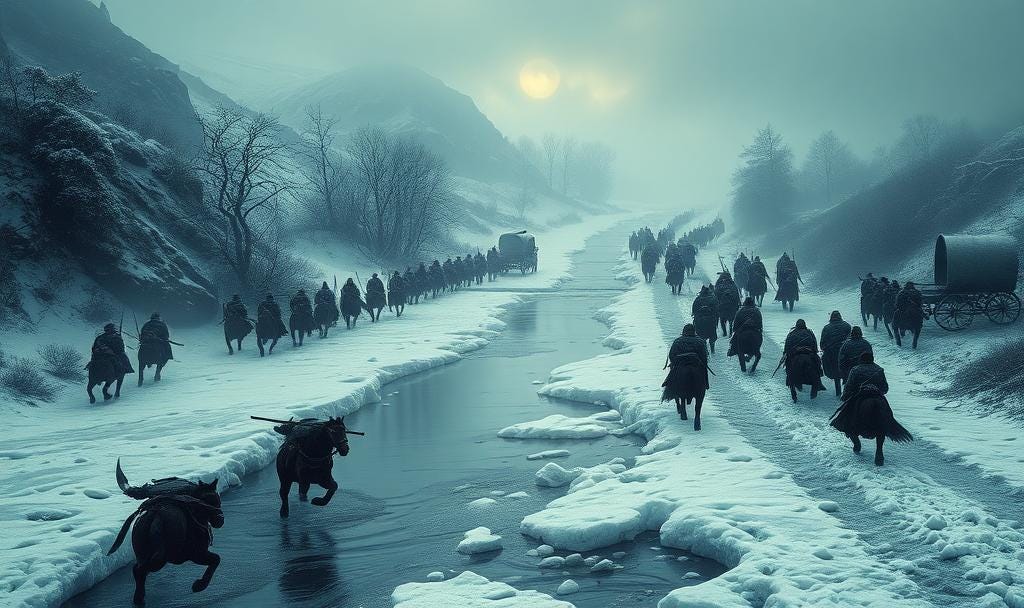
Introduction
The Sioux were a Great Plains tribe that fought many famous battles against the Americans in the 1800s. Among the Sioux greatest triumphs was the defeat of General Custer at Little Bighorn.
https://crackpot.substack.com/t/sioux

This post is a recommendation of an incredible work of history by John McDermott.
Context
Violence through the year 1864 culminates in the Sand Creek Massacre on November 29, 1864. Col. John Chivington stood by his final solution to the Indian problem until the end of his days, as did a number of his defenders and likeminded persons.
The Sioux, Cheyenne and Arapaho launch a campaign as avengers for Sand Creek. What followed was some of the worst fighting of the Indian wars.
The above infographic conveys the complicated picture and number of personalities involved in this conflict. The Americans allied with enemies of the Sioux, Cheyenne and Arapaho in the Shoshoni, Crow, Winnebago and Pawnee.
[1] The Sioux tribe is composed of many bands such as the Sans Arc, Hunkpapa, Oglala, Minniconjou and Brule. Each band has a number of famed chiefs.
The Kiowa and Comanche did not play a large part in the war, but Colonel Moonlight reports them as minor parties.
Roman Nose is a Cheyenne. Crazy Horse is n Oglala Sioux.
[2] George and Charles Bent are Cheyenne sons of William Bent. The Bents are ubiquitous on the frontier, as is [3] Jim Bridger. Bridger was previously seen in this series at the Fetterman Massacre.
[3]
General Sherman is famed for the Civil War and burning Atlanta. Sherman (and a host of other victorious Civil War officers) applied the same scorched earth supply chain dislocating tactic to Indian villages as part of their war strategy to devastating effect. The warriors may win on the battlefield, but having all their village stores burned, women and children killed or captured were not losses they could cope with.
Theatre
Out for justice, the Arapaho, Cheyenne, Sioux and other allies launched a series of raids and actions against many of the stations and ranches or other settlements along the Oregon Trail, Overland Trail, Bozeman Trail - and fought army attachments. This took place around the North & South Platte Rivers, Niobrara River and Republican Rivers in present day Northeast Colorado, Wyoming and Nebraska.
War Prompts
Julesburg
‘Every fifth house appears to be a bar, whiskey-shop, or lager-beer saloon; every tenth house either a brothel or gaming house or both.’ - Denver 1865.

While sacking Julesburg, George Bent found a new major’s uniform while looting the post office. Bent would later wear the uniform when meeting with the military to demand Colonel Chivington hanged. Bent was also with chiefs Dull Knife, Bull Bear and Red Cloud at the time.
Obviously the military did not acquiesce to the warrior’s demand for Chivington to hang to stop their war. Now may be as good a time as any to say it. So-called native war culture may be reframed as Hammurabi justice. In Sand Creek one finds an extreme example to demonstrate the rule - no matter what atrocity a white man committed against Indians; no crime was charged. What to do? Absent a formalized justice system, the back and forth of war culture may be reappraised as a primitive form of justice. As we saw in the Blackfoot raid, the entire thing was set in motion first by theft & murder and then the lack of any authority to prosecute the crimes.


Mud Springs & Rush Creek
General Collins believed there were White Men and Mexicans fighting alongside the Sioux… Some enlisted men of reported seeing a white man with long red hair and whiskers carrying a Texas Lone Star flag riding a sorrel horse. - Mcdermott pg. 39
Further complicating matters, white men apparently fought on the side of the Sioux against American soldiers. In one of the lesser remarked upon moments of Sand Creek, one of the few American casualties was caused when one soldier killed an old woman and a baby and another soldier shot that soldier dead.

Little Thunder, Spotted Tail’s Southern Brules and Swift Bear’s Corn Band came to make peace and join the friendly Brules and Oglalas known in some circles as the Laramie Loafers. For many years, these Lakota camped near Fort Laramie, intermarried with whites, and raised offspring. The Oglala Old Smoke, a fat and jovial Chieftan, had been the leader until he died in 1864 when Big Mouth took his place. Scorned by their brethren, these Indians were more aware of the overwhelming numbers of whites and the futility of war. - Mcdermott pg. 55
References
White, Lonnie J. Hostiles and Horse Soldiers. 1972.
Monnett, John H. The Battle of Beecher Island and the Indian War of 1867-1869. 1992.
Mcdermott, John. Circle of Fire. S.L., Stackpole Books, 2020.








